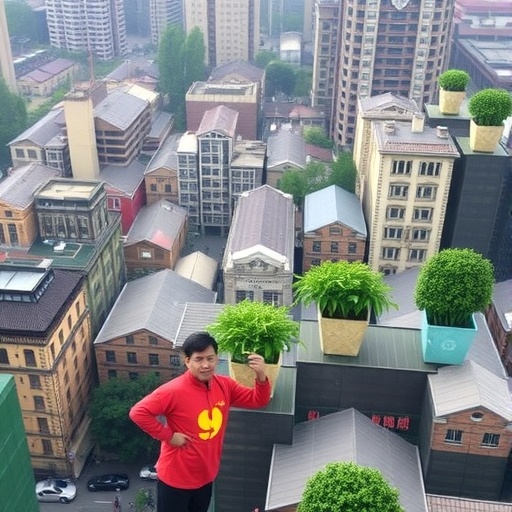As human populations continue to burgeon, urban areas have become the central hubs for economic activities, culture, and social interactions. In this context, significant transformations are taking place in the way cities are designed and built, particularly in rapidly developing countries like China. Findings from the research work titled “China’s urban vertical growth substantially influences global food security,” spearheaded by Han, Xu, and Tan, portray a profound interconnection between urban growth patterns, specifically vertical expansion, and global food security.
China’s ongoing vertical growth is a direct response to an escalating urban population that has increased dramatically over the past few decades. With the country’s urban population surpassing 600 million, the pressure to accommodate vast numbers of residents within the limited geographical scope of cities is immense. Researchers explore how the shift from horizontal expansion to vertical living arrangements is not merely an architectural trend but a strategic adaptation that has far-reaching consequences for resource distribution, especially food.
In assessing how vertical growth impacts food security, one must consider the intricate relationship between urban structures and agricultural practices. The study identifies that vertical cities can create significant changes in food supply chains. As urban centers build upwards, the relevance of local agriculture rises. Urban agriculture, and especially vertical farming systems, become integral to ensuring food availability directly within city limits. This reconfiguration of food production can lead to more sustainable practices and reduced carbon footprints, challenging traditional farming methods that depend heavily on rural landscapes.
Notably, decreasing the transportation distances associated with food distribution not only leads to fresher produce reaching the urban populace but also addresses food wastage. By reinforcing local food production systems within city boundaries, vertical urban formats first allow cities to utilize available space efficiently but also shift the burden from rural agricultural systems to urban ecosystems. This dual dynamic suggests that vertical growth could close the food security gap experienced by densely populated mega-cities.
Moreover, urban vertical growth presents unique challenges, particularly regarding energy efficiency and resource consumption. As buildings rise, they demand substantial energy and materials for construction and maintenance. The study highlights that a commitment to sustainable urban vertical design can mitigate these concerns. Employing smart technologies, such as energy-efficient systems and green building materials, can reduce the overall impact cities have on food production systems by promoting a more circular economy.
Climate change is another critical aspect that the research delves into when discussing food security in relation to urban vertical growth. As cities expand upwards, their role in combating climate change—through carbon sequestration, energy efficiency, and resource management—becomes pertinent. The ability of vertical structures to integrate green spaces, such as rooftop gardens and vertical farms, not only beautifies the cityscape but enhances biodiversity, promotes local food production, and reduces climate vulnerabilities. Such adaptations are essential in creating resilient urban environments that support food security even amidst changing climatic conditions.
Resources continue to be stretched thin as food demand increases in urban settings. The researchers indicate that cities must reconsider their food sourcing strategies, recognizing that urban agriculture could significantly alleviate supply issues. As zoning laws evolve to support vertical farming and urban gardens, cities can thrive towards self-sufficiency in food production. This focus on localized food systems encourages independence from long supply chains that are susceptible to disruption from global market fluctuations.
The implications of these findings extend beyond national borders, inviting a global discourse on urbanization trends and their environmental implications. Food security is a concern that transcends geopolitical boundaries, and the effects of China’s vertical growth model could influence global food policies and security measures. With a ripple effect on food systems worldwide, urban vertical growth in one nation can set precedents for others.
It is also vital for policy-makers to recognize the significance of integrated planning that encompasses residential, agricultural, and industrial sectors. Urban development must prioritize coexistence and synergy among these sectors to improve food security outcomes. Holistic strategies that connect urban planners, agriculturists, and stakeholders can foster environments that increase food production while sustaining urban living conditions.
In various parts of the world, cities are already beginning to embrace vertical growth principles, seeking to incorporate urban agriculture into their frameworks. The success stories emerging from innovative urban areas indicate that replicating China’s vertical growth could inspire progressive trajectories toward enhanced food security globally. It becomes evident that cities intent on sustaining food supplies must champion vertical integration as an ingrained urban ethos.
However, heed must be given to potential pitfalls associated with rapid vertical growth. As urban areas diversify and specialize, existing inequities can deepen without inclusive policies. The interdependence of socio-economic factors necessitates that advancements in urban food production are equitable and accessible to city residents. Future research must address the implications of vertical growth on marginalized communities to promote just and fair urban landscapes.
The urgency of addressing food security challenges amid climbing population figures and escalating urbanization is compelling. China’s ambitious move toward vertical living illustrates an impressive solution that intersects productive agricultural systems with urban life. Researchers call for the adoption of this model worldwide as a proactive response to ensure food security while fostering environmentally responsible urban atmospheres.
In conclusion, the intricate interplay between China’s urban vertical growth and global food security offers a revolutionary perspective on city planning and food distribution strategies. As lives converge in cities, the emphasis on vertical structures can transform our food systems. By utilizing the concepts explored in this research, global cities can seek sustainable solutions that ensure food security for generations to come.
Subject of Research: The impact of China’s urban vertical growth on global food security.
Article Title: China’s urban vertical growth substantially influences global food security.
Article References:
Han, J., Xu, X. & Tan, M. China’s urban vertical growth substantially influences global food security.
Commun Earth Environ (2025). https://doi.org/10.1038/s43247-025-03018-1
Image Credits: AI Generated
DOI: 10.1038/s43247-025-03018-1
Keywords: urbanization, food security, vertical growth, sustainable development, urban agriculture, China.




